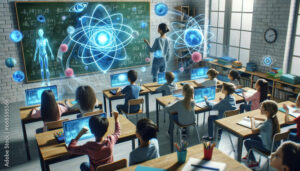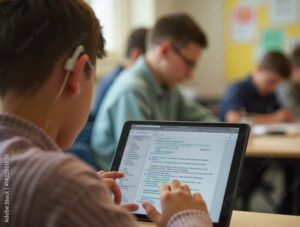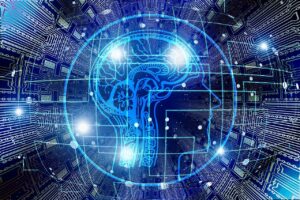Is the evolution of technology always beneficial?
As a Connected Educator (a teacher who uses technology to enrich students’ learning) in my school division, you would think that my opinion would be clear cut. However, I feel that to be a responsible tech-driven educator, you must be extremely critical of the technology used in the classroom. There are numerous questions that need to be asked and reflected upon before technology should become a staple in the classroom.
What are students gaining from this experience?
As we have seen the rapid evolution of technology, there are many benefits to its inclusion as a tool in the classroom. One of the most groundbreaking advantages is its ability to reduce barriers for students with diverse learning needs. Assistive technologies—such as speech-to-text tools, translation software, recording devices, and talking boards—can support students with disabilities or language barriers. As the demographics of our school populations change, more and more is being demanded of teachers with fewer resources. This assistive technology allows for a more personalized experience and eases the demands on teacher time. Furthermore, students who are shy or struggle with traditional forms of expression are afforded opportunities to communicate in ways that feel most comfortable and accessible to them. This approach helps foster a more inclusive and equitable learning environment for all students.
Technology also opens the door to multiple forms of expression. Instead of relying solely on written tests or essays, students can demonstrate their understanding through multimedia presentations, audio recordings, and visual art, which may better align with their individual strengths. This inclusion of multiple forms of expression brings education closer to fulfilling important educational Calls to Action set forth by the Truth and Reconciliation council. While school divisions work towards reconciliation through multiple pathways, viewing educational practices through a reconciliation lens allows for meaningful change and movement towards decolonization. In the same breath, technology enables connection. Students can collaborate more easily with their peers, access professionals and mentors from around the world. Some school divisions have used technology to ensure the teachings and lessons of elders and knowledge keepers are protected for future generations to learn from. Technology enriches the information students consume and deepens their connection with the world around them. The availability of instant resources—such as how-to videos, online dictionaries, audiobooks, and instructional guides—also empowers learners to explore topics of personal interest, seek explanations of difficult concepts in a manner that is more accessible to them, and deepen their understanding at their own pace. It is important to remember that while it does provide substantial benefits, it does come at a cost to the division. Divisions can only provide the technology that is in high demand, not all technologies that would benefit students.
How are students not benefiting from technology?
The use of technology in the classroom is not without its challenges. One of the most daunting challenges is the issue of technological equity. For some students, particularly those without access to devices or internet at home, all homework must be completed during school hours, creating inequities in learning opportunities. While it has become an common assumption that internet connection is universal, this is not the reality for all families. For some students, the only computer access they might have is the public library -which may not be in the immediate vicinity. While some school divisions are working towards addressing some of these inequities, not all school divisions are willing to expend capital to address this issue. There are concerns, amongst teachers and administrators alike, that these very tools that enhance learning can also be sources of distraction. Games, social media, and even inappropriate content such as pornography are only a few clicks away, posing significant risks to focus, safety, and well-being. Again, some school divisions have worked towards eliminating this problem through use of surveillance software, but not all divisions have implemented this policy. Some divisions focus more on digital citizenship with the belief that students will make the right choice. As a middle years teacher, I can attest that this is not the answer. Students will always find a way to go what they want. Even the most unassuming student can have an alarming digital footprint. Teachers need to be technology guides and ensure they provide a safe environment to learn in. Some corners of the internet are far from safe. I will touch on this later. With this constant access to the internet and social media, students can also fuel issues like cyberbullying. This type of bullying can continuously impact students no matter where they are, and impact their mental health and academic performance. It has been proven that this type of bullying is dangerous and, sometimes, fatal for children. This issue will be further agitated with the increased use of Artificial Intelligence (AI).
 AI tools are a hotly debated issue in education today. From writing assistants and translation programs that blur the line between help and dishonesty, to AI facial reconstruction and voice imitation leading to horrific cyberbullying issues – AI proves to be contentious. While I will discuss this topic at length next week, it is important to note its presence in this discussion. The writing and translation programs concern educators regarding plagiarism and the reliance on academic shortcuts and not personal achievement. Another growing concern is the decline of traditional skills. Students relying heavily on digital tools, may not learn or retain skills that are still relevant in many contexts—such as using a physical dictionary, doing mental math, or navigating non-digital resources. Even though our world is moving towards being completely digital, that shift has not been completed (if it is ever to). Furthermore, students need to be explicitly taught the benefit of balance between technology and manual skills. Both hold validity in reality, but each teach and develop different skills in the mind. To prepare our students for the future, it is best to teach them as many skills as possible, as we are not fortune tellers and cannot foresee the future.
AI tools are a hotly debated issue in education today. From writing assistants and translation programs that blur the line between help and dishonesty, to AI facial reconstruction and voice imitation leading to horrific cyberbullying issues – AI proves to be contentious. While I will discuss this topic at length next week, it is important to note its presence in this discussion. The writing and translation programs concern educators regarding plagiarism and the reliance on academic shortcuts and not personal achievement. Another growing concern is the decline of traditional skills. Students relying heavily on digital tools, may not learn or retain skills that are still relevant in many contexts—such as using a physical dictionary, doing mental math, or navigating non-digital resources. Even though our world is moving towards being completely digital, that shift has not been completed (if it is ever to). Furthermore, students need to be explicitly taught the benefit of balance between technology and manual skills. Both hold validity in reality, but each teach and develop different skills in the mind. To prepare our students for the future, it is best to teach them as many skills as possible, as we are not fortune tellers and cannot foresee the future.
Who is benefiting from our use of this technology outside of the classroom? Can we guarantee privacy?
The question of who truly benefits from our increasing reliance on technology in education is one that deserves critical examination. While the goal is to enrich student learning, we cannot overlook the fact that the corporations that provide educational platforms also financially benefit. From the digital
footprint that each person in the school creates, to the subscriptions that school divisions and teachers pay to have full access to a program, these companies benefit. The question then remains: Can we truly guarantee student privacy when profit can be made from their data? I don’t believe we can. As educators, we need to explicitly teach students about safe surfing, digital footprints, and the lifelong implications of sharing information online. Digital citizenship can no longer be a lesson taught at the beginning of the year. It must be a foundational aspect of our school culture and the curriculum we teach. However, our curriculum is outdated and the possibility of it being updated is highly unlikely (just ask high school history teachers). Unfortunately, technology is evolving faster than our ability to adapt our educational policies (let alone our federal laws) and curriculum to match this new world our students are facing. It is becoming harder and harder to teach digital safety effectively when the tools change faster than policies or professional development can keep up. Until curriculum evolves to meet the pace of technological advancement, students privacy remains vulnerable.
Finally, I do want to quickly mention (seeing as the dark web is trending on TikTok) that there are browsers that allow you to access the dark web rather easily. According to our IT coordinator, the internet platform Brave easily connects to the dark web. How many people know this, I am not sure, but it was an eye opening conversation to have with one of my students. They had no idea (I believe them) that there was this capability. They explained that they believed it was safe because their parent had it on their government owned cell phone. Brave is a more “private” browser that focuses on privacy by not collecting or sharing data. Due to this, it does “protect” (as much as a browser can) the user from the dark web accessing your browser when not on the dark web. However, Brave is not a safe browser to use on the dark web as it is easy to monitor users. I know this sounds alarmist, but as this is a topic trending on TikTok, I felt it necessary to mention.
Is the exchange of skill-building areas worth the exchange?
So, is the exchange of skills, from manual to technologic, work it? If we are truly preparing students for life beyond school, should we allow digital tools to replace writing, reading, listening, or research? In my opinion, there needs to be a healthy balance. While the internet and all technological skills are important, there are aspects to all careers that require “traditional skills”. If we fail to teach our students these skills, we risk sending them into the world unprepared to succeed. While AI and tech provide convenience, they also provides opportunity to become apathetic and permissive regarding education. While this is a risk, I feel that the students who would choose technology to do their work would find a way either way. Furthermore, not every student has consistent access to technology at home, and those without it lose critical learning opportunities that might otherwise be realized. The erosion of traditional skills like using a dictionary, reading for extended periods, or conducting research from physical books isn’t just nostalgic—it’s consequential. These practices teach patience, comprehension, and perseverance. When everything is instantaneous, students do not have the opportunity to learn and practice these skills in their everyday life. We must be intentional with our choices with and use of technology.


Thanks for sharing your thoughts on technology in education. I really like how you pointed out both the good and the tough parts of using tech in the classroom. I agree that we need to be careful and thoughtful about how we use it. The way you talked about assistive tools helping students with different needs really stood out to me as well. Technology can definitely make learning more fair and accessible, but I also agree that not every student has access to devices or the internet at home, which makes things harder for some kids.
Your concerns about AI and students relying too much on technology are important too. It’s true that students still need to learn basic skills like mental math and how to research without always depending on digital tools. Teaching digital safety and citizenship is something we have to keep working on, not just teach once.
These are some of the things I’ll be discussing in my debate next week, so your reflection gave me a lot to think about. Overall, your points remind me that using technology well means finding a good balance and always keeping students’ needs at the center. Thanks for the great reflection and great work on your debate!
Thanks for your thoughtful post, as always! I really enjoyed the way you broke down both the advantages and the unintended consequences of our ever-evolving tech world. Your point about how “efficiency does not always equal improvement” really resonated with me. It’s something I’ve been reflecting on too, especially as I look at the trade-offs we’re seeing in our classrooms and homes.
In my own blog post on this topic, I touched on a similar tension – how even though technology can open doors to connection, creativity, and instant access to information, it can also quietly erode things like patience, presence, and authentic learning experiences. Like you, I’ve noticed how even with all this innovation, some core pieces of childhood and learning are being lost or altered in subtle but powerful ways.
Your idea of “asking questions instead of accepting all new tech as progress” really stuck with me. I think as educators (and parents too!), it’s our responsibility to be those critical voices – not just to resist change, but to guide it in a way that protects what matters most. I think by leadin by example in this way, we can hopefully teach our students and children to do the same. Thanks again for the reflective read; I always appreciate how grounded and real your posts are!